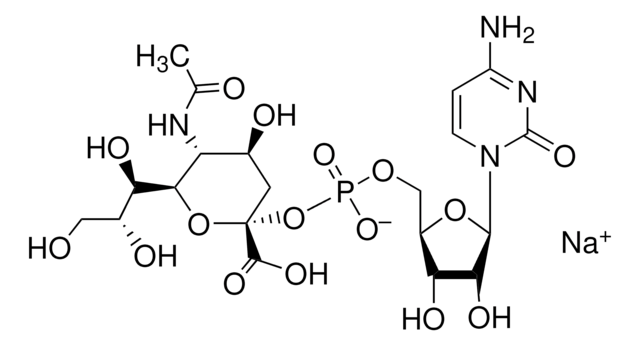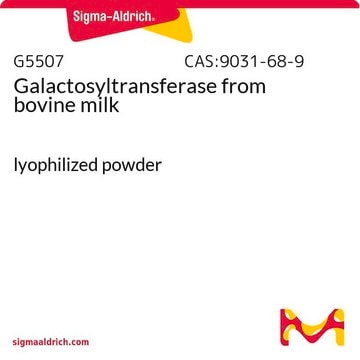SAE0090
Beta-galactoside alpha-2,6-sialyltransferase 1
≥300 units/mg protein, ST6GAL1 human recombinant, expressed in HEK 293 cells
别名:
Alpha 2,6-ST 1, B-cell antigen CD75, CMP-N-acetylneuraminate-beta-galactosamide-alpha-2,6-sialyltransferase 1, ST6Gal I, Sialyltransferase 1
登录查看公司和协议定价
所有图片(3)
About This Item
推荐产品
重組細胞
expressed in HEK 293 cells
描述
The specific activity of ST6Gal I is measured by its ability to transfer sialic acid from CMP-NANA to asialofetuin.
化驗
≥95% (SDS-PAGE)
形狀
lyophilized powder
比活性
≥300 units/mg protein
運輸包裝
ambient
儲存溫度
−20°C
相关类别
一般說明
Recombinant human Beta-galactoside alpha-2,6-sialyltransferase 1 (ST6Gal I) is expressed in human HEK 293 cells as a glycoprotein with a calculated molecular mass of 43.5 kDa (amino acids 27-406). The DTT-reduced protein migrates as a ~50 kDa polypeptide on SDS-PAGE due to glycosylation. This protein is manufactured in human cells, with no serum. The human cells expression system allows human-like glycosylation and folding, and often supports higher specific activity of the protein. The protein is produced with no artificial tags.
生化/生理作用
ST6Gal I catalyzes the transfer of CMP-N-acetylneuraminate (CMP-sialic acid, CMP-NANA) to the β-D-galactosyl-1,4-N-acetyl-D-glucosaminyl termini on glycoproteins. Sialic acids are distributed in a variety of glycolipids and glycoproteins.1 The sialic acid that is added to a galactose (Gal) can be bound either to the hydroxyl attached to carbon-3 of Gal to form an α-2,3 glycosidic linkage, or to the hydroxyl group attached to carbon-6 to form an α-2,6 glycosidic linkage.1 ST6Gal I generates a α-2,6 linkage of sialic acid on the non-reducing, terminal Galβ1 4GlcNAc residues of oligosaccharides and glycoconjugates.2
Terminal sialylation has been shown to decrease Fcγ receptor binding and increase anti-inflammatory activity,3 as well as antibody-dependent cellular cytotoxicity in different studies by reduced binding of sialylated antibody towards FcγRIIIa.4-5
This recombinant ST6Gal I product can be used to study the mode of action of the enzyme, as well as its potential inhibitors. It can also be used as a glycoengineering tool to modify glycoproteins in vitro.
CMP-N-acetylneuraminate (CMP-sialic acid, CMP-NANA) to the β-D-galactosyl-1,4-N-acetyl-D-glucosaminyl termini on glycoproteins.
Sialic acids are distributed in a variety of glycolipids and glycoproteins. The sialic acid that is added to a galactose (Gal) can be bound either to the hydroxyl attached to carbon-3 of Gal to form an α-2,3 glycosidic linkage, or to the hydroxyl group attached to carbon-6 to form an α-2,6 glycosidic linkage. ST6Gal I generates a α-2,6 linkage of sialic acid on the non-reducing, terminal Galβ1 4GlcNAc residues of oligosaccharides and glycoconjugates.
Terminal sialylation has been shown to decrease Fcγ receptor binding and increase anti-inflammatory activity, as well as antibody-dependent cellular cytotoxicity in different studies by reduced binding of sialylated antibody towards FcγRIIIa.
Terminal sialylation has been shown to decrease Fcγ receptor binding and increase anti-inflammatory activity,3 as well as antibody-dependent cellular cytotoxicity in different studies by reduced binding of sialylated antibody towards FcγRIIIa.4-5
This recombinant ST6Gal I product can be used to study the mode of action of the enzyme, as well as its potential inhibitors. It can also be used as a glycoengineering tool to modify glycoproteins in vitro.
CMP-N-acetylneuraminate (CMP-sialic acid, CMP-NANA) to the β-D-galactosyl-1,4-N-acetyl-D-glucosaminyl termini on glycoproteins.
Sialic acids are distributed in a variety of glycolipids and glycoproteins. The sialic acid that is added to a galactose (Gal) can be bound either to the hydroxyl attached to carbon-3 of Gal to form an α-2,3 glycosidic linkage, or to the hydroxyl group attached to carbon-6 to form an α-2,6 glycosidic linkage. ST6Gal I generates a α-2,6 linkage of sialic acid on the non-reducing, terminal Galβ1 4GlcNAc residues of oligosaccharides and glycoconjugates.
Terminal sialylation has been shown to decrease Fcγ receptor binding and increase anti-inflammatory activity, as well as antibody-dependent cellular cytotoxicity in different studies by reduced binding of sialylated antibody towards FcγRIIIa.
單位定義
One unit is defined as the amount of enzyme required to transfer 1.0 nanomole of sialic acid from CMP-NANA to asialofetuin per minute at pH 6.0, 37oC.
儲存類別代碼
11 - Combustible Solids
水污染物質分類(WGK)
WGK 2
閃點(°F)
Not applicable
閃點(°C)
Not applicable
Makoto Ogata et al.
BMC biotechnology, 9, 54-54 (2009-06-09)
Sialic acid is a deoxy uronic acid with a skeleton of nine carbons which is mostly found on cell surface in animals. This sialic acid on cell surface performs various biological functions by acting as a receptor for microorganisms, viruses
Bernard J Scallon et al.
Molecular immunology, 44(7), 1524-1534 (2006-10-19)
Although it is now clear that certain Fc glycan structures on immunoglobulin G (IgG) antibodies (Abs) can have a dramatic influence on binding to selected Fcgamma receptors (FcgammaR) and on Fc-mediated immune functions, the effects of all known Fc glycan
Yoshikatsu Kaneko et al.
Science (New York, N.Y.), 313(5787), 670-673 (2006-08-05)
Immunoglobulin G (IgG) mediates pro- and anti-inflammatory activities through the engagement of its Fc fragment (Fc) with distinct Fcg receptors (FcgRs). One class of Fc-FcgR interactions generates pro-inflammatory effects of immune complexes and cytotoxic antibodies. In contrast, therapeutic intravenous gamma
J Weinstein et al.
The Journal of biological chemistry, 257(22), 13835-13844 (1982-11-25)
A Gal beta 1 to 4GlcNAc alpha 2 to 6 sialyltransferse and a Gal beta 1 to 3(4)GlcNAc alpha 2 to 3 sialyltransferase have been purified 23,000- and 860,000-fold to homogeneity from Triton CF-54 extracts of rat liver membranes. The
Michael F Naso et al.
mAbs, 2(5), 519-527 (2010-08-19)
Covalently-linked glycans on proteins have many functional roles, some of which are still not completely understood. Antibodies have a very specific glycan modification in the Fc region that is required for mediating immune effector functions. These Fc glycans are typically
商品
Explore tools for glycosyltransferase synthesis and modification of glycans, such as glycosyltransferases and nucleotide sugar donors.
Enzymatic glycosyltransferase specificity challenges the one enzyme-one linkage concept.
我们的科学家团队拥有各种研究领域经验,包括生命科学、材料科学、化学合成、色谱、分析及许多其他领域.
联系技术服务部门







